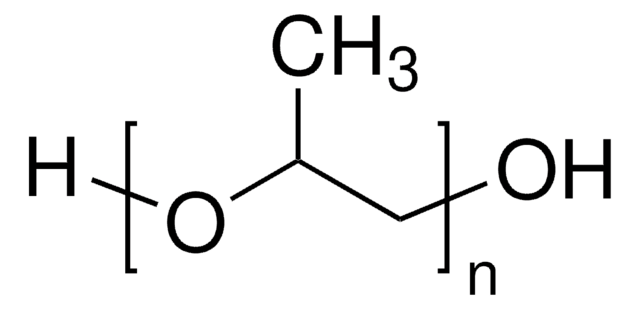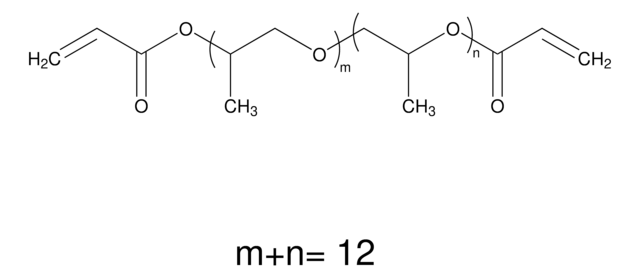Alle Fotos(1)
Wichtige Dokumente
81350
Polypropylenglycol
P 400
Synonym(e):
1,2-propanediol
Anmeldenzur Ansicht organisationsspezifischer und vertraglich vereinbarter Preise
Alle Fotos(1)
About This Item
CAS-Nummer:
MDL-Nummer:
UNSPSC-Code:
12162002
PubChem Substanz-ID:
NACRES:
NA.23
Empfohlene Produkte
Qualitätsniveau
Form
liquid
Mol-Gew.
Mn 446
Brechungsindex
n20/D 1.447
Viskosität
~100 mPa.s(20 °C)
Löslichkeit
water: miscible (completely)
Dichte
1.01 g/mL at 20 °C
SMILES String
O(C(CO)C)CC(O)C
InChI
1S/C6H14O3/c1-5(8)4-9-6(2)3-7/h5-8H,3-4H2,1-2H3
InChIKey
DUFKCOQISQKSAV-UHFFFAOYSA-N
Suchen Sie nach ähnlichen Produkten? Aufrufen Leitfaden zum Produktvergleich
Verwandte Kategorien
Allgemeine Beschreibung
Propylenglykol ist ein aliphatischer Alkohol. Es ist ein Additionspolymer aus Propylenglykol und Wasser, dargestellt als H[OCH3]n, wobei n die durchschnittliche Anzahl der Oxypropylengruppen darstellt.
Anwendung
Propylenglykol (PPG) kann als viskositätsverringerndes Mittel, als Lösungsmittel und als Duftstoff in Kosmetika verwendet werden. PPG kann als gutes Quellmittel für die Synthese von großporigen mesoporösen Materialien verwendet werden.
Lagerklassenschlüssel
10 - Combustible liquids
WGK
WGK 1
Flammpunkt (°F)
201.2 °F - closed cup
Flammpunkt (°C)
94.0 °C - closed cup
Persönliche Schutzausrüstung
Eyeshields, Gloves
Hier finden Sie alle aktuellen Versionen:
Besitzen Sie dieses Produkt bereits?
In der Dokumentenbibliothek finden Sie die Dokumentation zu den Produkten, die Sie kürzlich erworben haben.
Kunden haben sich ebenfalls angesehen
Preparation and characterization of organo-modified SBA-15 by using polypropylene glycol as a swelling agent
Park BG, et al.
Microporous and Mesoporous Materials : The Official Journal of the International Zeolite Association, 66(2), 229-238 (2003)
Anup Aggarwal et al.
Cell, 170(2), 249-259 (2017-07-04)
Widespread resistance to first-line TB drugs is a major problem that will likely only be resolved through the development of new drugs with novel mechanisms of action. We have used structure-guided methods to develop a lead molecule that targets the
Mohammed Taghi Zafarani-Moattar et al.
Biotechnology progress, 28(1), 146-156 (2011-09-29)
In this work, we proposed a novel aqueous biphasic system (ABS) composed of polypropylene glycol P400 (PPG P400) and hydrophilic ionic liquids (IL), 1-alkyl-3-methylimidazolium bromide (alkyl = ethyl or butyl), forming an upper polymer-rich phase and a lower IL-rich phase
Celeste R Brennecka et al.
World neurosurgery, 78(5), 469-480 (2011-11-29)
Current treatments for cerebral aneurysms are far from ideal. Platinum coils are prone to compaction, and currently used liquid embolics are delivered with angiotoxic agents. This work presents initial in vivo studies of a novel liquid-to-solid gelling polymer system (PPODA-QT)
John Texter et al.
Macromolecular rapid communications, 33(1), 69-74 (2011-12-03)
The controlled atom transfer radical polymerization of an ionic liquid, 1-(11-acryloylundecyl)-3-methyl imidazolium bromide (ILBr), from both ends of a telechelic poly(propylene oxide) (PPO) macroinitiator, end-functionalized with bromoisobutyryloyl is reported. The resulting highly water-soluble triblock, poly(ILBr-b-PO-b-ILBr) is multistimuli responsive. This new
Unser Team von Wissenschaftlern verfügt über Erfahrung in allen Forschungsbereichen einschließlich Life Science, Materialwissenschaften, chemischer Synthese, Chromatographie, Analytik und vielen mehr..
Setzen Sie sich mit dem technischen Dienst in Verbindung.



